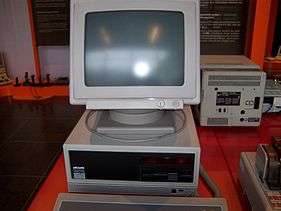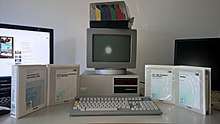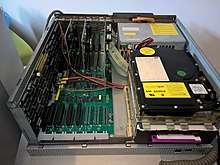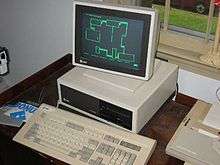Olivetti M24
 | |
| Manufacturer | Olivetti |
|---|---|
| Type | Personal computer |
| Release date | 1983 |
| Discontinued | 1989 |
| Operating system | MS-DOS |
| CPU | Intel 8086 @ 8 MHz |
| Memory | 128 KB or 256 KB (expandable to 640 KB) |
| Successor | Olivetti M240 |
The Olivetti M24 is a computer that was sold by Olivetti in 1983 using the Intel 8086 CPU.[1]
The system was sold in the United States under its original name by Docutel/Olivetti of Dallas.[2] AT&T and Xerox bought rights to rebadge the system as the AT&T PC 6300[2][3][4] and the Xerox 6060 series, respectively.[5][6] (AT&T owned 25% of Olivetti around this time.[2]) The AT&T 6300, launched in June 1984, was AT&T's first attempt to compete in the PC compatible market.[3]
Features
Contrary to other PC clones of that era, the M24 was highly compatible with IBM PC. One of its characteristics was the use of the more powerful 8.0 MHz Intel 8086 CPU rather than the 4.77 MHz Intel 8088 used in IBM's own PC XT,[7] configured for "maximum mode" that allowed direct installation of an 8087 math co-processor (also at 8 MHz) to the motherboard. The CPU clock, along with most others in the machine (other than the serial baud rate generator and an IBM-standard 14.3 MHz crystal used on the expansion board), was divided down from a 24.0 MHz master crystal, with the CPU timing in particular using an Intel 8284 clock generator, as per the IBM PC, to produce the 33% duty cycle squarewave required by the 8086.
The system was designed "split-level", with the motherboard screwed onto the underside of the computer case and connected to the ISA bus backplane in the top section of the case via the video card which, rather than occupying an ISA slot, has two female edge connectors and plugs onto the ends of both the motherboard and the backplane, doubling as a bridge between them. The M24 has seven 8-bit ISA slots, as were standard for its time, but a number of slots (exact figure seeming to vary between one and at least four across extant machines) have proprietary second connectors to accept Olivetti-specific 16-bit cards. The machine had the bad luck of launching just a few months before the IBM PC-AT, which introduced the entirely different 16-bit connector and signalling standard extension to the PC bus now known simply as "ISA", and so ended up featuring slots incompatible on all three fronts of physical configuration, complement and arrangement of signals, and data transfer rate, significantly restricting the number of compatible 16-bit cards produced for it.
The initial release of the AT&T 6300 had either one or two 360k 5.25" floppy drives; a hard disk was not offered. In 1986, AT&T began offering 3.5" 720k floppies and 20MB hard disks. The Xerox 6060 came standard with a single 360k 5.25" drive and a 20MB hard drive. An Iomega Bernoulli 10/10 removable cartridge drive was also offered as a factory option, as well as a "small expansion" sidecar hosting a hard drive for users who found themselves with no internal space left between floppies and expansion cards.
6300s made in 1986-1987 have BIOS Version 1.43 which added proper support for 3.5" floppies and fixed a number of bugs. As with all contemporary systems, a BIOS upgrade required a physical chip replacement, which AT&T provided for $35.[8]
The M24/6300 had an unusual enhanced 32 KiB CGA-compatible video card which, in addition to standard 200-line CGA graphics modes (automatically line doubled, transparent to software, with text modes also using 400 scanlines with higher quality 8x16 pixel fonts, or even 16x16 in 40-column mode with an expansion ROM), also supported an additional 640x400 pixel graphics mode, as well as a poorly documented 512x256 mode for compatibility with the earlier M20 model (in conjunction with a Z8000-based emulator card that included a necessary additional clock source). All modes were non-interlaced, albeit running at a then-common 50 Hz Vsync rate, and required the dedicated OEM 26.3 kHz, 12" monitor (either colour or multi-level monochrome) because of their comparatively high line frequency, with all but the M20 mode using the 24 MHz system master crystal to drive the pixel clock either directly or (320x200 and 8x16 40-character only) divided in two (in comparison, contemporary IBM displays ran at 15.8 to 21.9 kHz with 14.3 to 16.3 MHz dot clocks).[9]
Colour depth remained the standard fixed 4-colour CGA palettes in 320x200, and "monochrome" in all higher modes (any selectable RGB(I) foreground colour/one of 15 shades, with a fixed black background), but could be expanded to 4 or 8 colours/greyscales in all resolutions, and 16 in all but 512x256, with the addition of a graphics memory expansion board holding between 32 and 96 KiB RAM (the resolution:colour relationship being unintuitive due to CRTC bandwidth and addressing limitations - 16 colours in the 640-pixel modes effectively combined the standard and expansion memory spaces into a single 64-bit wide bank); the expansion card also had its own monitor port built in allowing native dual-monitor support.
CGA compatibility was necessarily limited to "RGB" modes, and "well behaved" software that only used the BIOS-preset modes and didn't attempt too much clever direct reprogramming of the CRTC registers (including setting of pseudo-text hack modes like 160x100 16 colours), as there was no composite video output available and although some basic register settings remained the same, others were necessarily very different because of the line doubling trickery (itself a type of CRTC hack) and altered scan rates, and Olivetti's protective "scrambler" chip that attempted to convert custom settings to the nearest safe equivalents could only go so far. In its turn, the machine's headline 640x400 graphics mode received a moderate level of support from software developers, mostly for "serious" applications such as Lotus 1-2-3 and Symphony (Earl Weaver Baseball is however an example of a game that can use it), and was for a time both supported and emulated (as well as extended to e.g. 752x410) by various "Super EGA"/"any mode on any monitor" cards such as the ATI EGA Wonder. These, as well as any other replacement video card, could be used in the 6300 so long as they were designed to work either specifically with the machine (for high speed 16-bit cards), or in an IBM PC compatible mode (necessarily 8-bit at 4.77 MHz). However, the original graphics card had to remain in place even if no longer in use, as it formed an essential part of the bridge connecting the expansion board to the motherboard, and although it featured DIP switch jumpers to select between MDA/Hercules, 40 and 80 column CGA, and expanded video options including its own (as per the IBM motherboard settings), there was no "disable" switch. Instead, the (socketed) Motorola HD6845 CRTC main controller chip had to be removed, and replaced with a simple but remarkably expensive bridging circuit (or a user installed set of jumper wires to the correct half-dozen socket terminals) to bypass the necessary bus signals through the card untouched.
Some plasma-screen and early LCD based portables from Compaq and other manufacturers also copied the M24/6300's graphics hardware to make better use of early square-pixel 640x400 panels popular for Japanese and other non-IBM portables (still well suited to the basic CGA/EGA resolutions, but not so much EGA-high or MDA/EGA text, and unable to show MCGA/VGA-high or Hercules graphics without cropping or losing details) in an IBM Compatible hardware ecosystem that otherwise avoided the mode. However, it remained on the whole a poorly supported oddity, much like IBM's own PGC and most Super EGAs outside of their limited library of applications with direct driver support, and PC graphics on the whole did not exceed 640x350 in 16 colours or 720x348 in monochrome until the arrival of both the VGA standard, and Windows 3.0 which provided a simple one-driver-for-all-programs framework for future expansion cards to build on.
The keyboard used a proprietary 9-pin D-sub connector built into the system board and had the unusual option of plugging a mouse into the keyboard via another 9-pin D-Sub connector. The mouse could be configured to simulate the usage of the keyboard's arrow keys in DOS applications without mouse support, aided by the choice of a parallel quadrature encoding design (as per the Microsoft Bus Mouse, Amiga and Atari ST mice, all of which can be modified to work with the 6300) instead of the latterly more common 9-pin serial transmission.
In Europe, Olivetti also launched a 10.0 MHz version: the Olivetti M24 SP, announced in November 1985,[10] a contender for the title of "highest clocked 8086 computer" as its processor was the fastest grade of 8086-2, rated for a maximum speed of exactly the same 10.0 MHz. To support this, the motherboard now featured a switchable 24/30 MHz master crystal, still divided by 3 to produce the 33% duty CPU clock, with an additional 4 MHz crystal to maintain that clock signal for peripherals that required it, and the video board receiving its own 24 MHz crystal to maintain the same image size and scan frequencies at both processor speeds.
Reception


A January 1985 review in Infoworld declared it "a fair performer, better than the 8088-equipped IBM PC and PC XT and about equal to the 8086-based Compaq Deskpro", and taking pricing into account concluded that it was "a good deal, but by no means perfect." The reviewer wondered how the "5 MHz" 8086 in the Compaq ran as fast as the same processor at 8 MHz in the AT&T machine;[11] however, this appears to be a misunderstanding given that the Compaq was switchable between a guaranteed IBM PC-compatible 4.77 MHz and an enhanced-performance 7.16 MHz clock rate (respectively one-third and one-half of the same NTSC colourburst crystal used in the IBM, but not the Olivetti/AT&T), and defaulted to the latter on boot, as detailed in other publications of the time,[12] and endlessly misreported (including as "8 MHz", about as frequently as the miscalculated "7.14 MHz") ever since. The reason behind the M24/6300's failure to perform any better than equal with the 1/9th-slower Deskpro may be traceable, as hinted at in the Infoworld review, to poorly optimised graphics routines in the BIOS, which would have a particularly noticeable effect in the high resolution 640x400 and extended colour modes.
A November 1985 review in PC Magazine of the hard drive-equipped version found it on par with the (6 MHz, 80286 equipped) IBM PC AT as far as processor performance was concerned, but with considerably slower I/O.[4]
The initial model of the AT&T 6300 (no hard disk and only 360K floppy) had slow sales in 1984 with only 28,500 sold compared to 1.5 million IBM PCs.[13] The sales were not much better in the first three months of 1985, with only 8,500 sold in that time period.[2] If fact, worldwide sales of the Olivetti M24 were only 42,000 in the first year, well below the planned production capacity of 200,000.[14] As a result, AT&T introduced the faster models with hard drive and a math co-processor in March.[2] Still, after about one year on the market, AT&T had only claimed about 1% of the PC market, on par with that of TeleVideo and Columbia Data Products, but well below that of Compaq and Kaypro.[3] By December 1986 however, AT&T's PC line (including the 6300 Plus, described below) put it in the fourth place in terms of market share in the US.[15]
Olivetti's M24 did much better in Europe, where it became the market leader in 1986.[16] The company produced almost half a million M24 machines that year, about 200,000 of which went to the United States.[17] As it claimed the crown of most PC machines sold in Europe that year, Olivetti also became the third largest PC manufacturer worldwide.[17] Olivetti would however be unable to repeat the feat in the subsequent years, and so 1986 represents the company's apogee in terms of PC market share.[17]
The 6300 was also supported by Unix-based operating systems particularly by Venix/86 Encore, released in September 1984,[18] and by a version of Xenix adapted for the machine by the Santa Cruz Operation, and announced in June 1985.[19]
6300 Plus and subsequent AT&T machines

In October 1985, AT&T launched the 6300 Plus[20] that used a 6 MHz 286 microprocessor in the same case as the 6300. On the hardware level, this machine was criticized by a Infoworld reviewer for being incompatible with AT cards.[21] On the other hand, AT&T sold a package of the 6300 Plus bundled with Simultask, which ran MS-DOS and UNIX System V simultaneously, at a cost—with all software licenses included—on par with the IBM PC AT with MS-DOS alone.[22] A review in PC Magazine declared that AT&T's 6300 Plus was "flat out the better machine" compared to the IBM PC AT.[23] (The version of Simultask included with this machine was based on Locus Computing Corporation's Merge software.[20][24] According to AT&T, their 6300 Plus used non-standard hardware to make such a feat possible given the limitations of the 80286.[25]) The PC6300 Plus shipped with MS-DOS in 1985 though, because its Unix System V distribution would not be ready until the end of March 1986.[26] The 6300 Plus did not sell as well as the original 6300.[15] Forrester Research estimated in December 1986 that AT&T's financial losses in PC market were about $600M for the year.[15]
After the 6300 Plus, AT&T announced that it was turning over both production and development of its PC products to Olivetti.[15] In 1987, AT&T offered a true AT-based 286, their 6310—a rebadge of Olivetti M28.[27] Equipped with a one-wait state 8 MHz processor, it was a pretty slow machine for its class, even slower than the IBM XT 286.[28] Simultask was also an option for the 6310. The later-released 6312 addressed the speed problem with a 12-MHz CPU.[28] After the announcement of the 6310, in April 1987, AT&T announced price cuts across its 6300 PC product line, with the 6300 Plus discounted by 27-38%, while the original 6300 was discounted by 17-23% (depending on configuration.)[29]
Successors in Olivetti's product line
In response to IBM's launch of their PS/2 line, Olivetti revamped their product line in July 1987 to include 3.5" floppy drives (in 5.25-to-3.5" converted bays though) and also introduced new 386-based products. The M24 (and M24 SP) were succeed by the M240 (8086 at 10 MHz, which AT&T marketed in the USA as the 6300 WGS) while the M28 (and M28 SP) was succeed by the M280 (80286 at 12 MHz). Olivetti also introduced an M380 series (both tower and desktop) using the 80386 processor.[30]
See also
References
- ↑ "Olivetti M-24 @ Computer Museum .it". Computermuseum.it. Retrieved 2016-04-01.
- 1 2 3 4 5 AT&T Faces AT Clone Dilemma. InfoWorld Media Group, Inc. 8 July 1985. p. 21. ISSN 0199-6649.
- 1 2 3 AT&T having trouble in computer market. Computerworld. 13 May 1985. pp. 93, 100. ISSN 0010-4841.
- 1 2 "PC Mag". Books.google.com. 1985-11-12. p. 112. Retrieved 2016-04-01.
- ↑ Xerox 6060 review in Byte Magazine Volume 11 Number 09, (September 1986) pp. 275-278
- ↑ "Zweites Bein im amerikanischen Mikromarkt:: Olivetti liefert auf OEM-Basis M24-Mikro auch an Xerox". Computerwoche.de. 1985-05-10. Retrieved 2016-04-01.
- ↑ "The Museum". Old-Computers.Com. Retrieved 2016-04-01.
- ↑ Scott M. Mueller (1994). Upgrading and Repairing PCs (4th ed.). Que Publishing. p. 858. ISBN 1-56529-932-9.
- ↑ "Olivetti M21/M24 Theory of Operation" (PDF). Bitsavers.de. 1984. Retrieved 2018-07-11.
- ↑ "Olivetti-Mikro verfügbar". Computerwoche.de. 1985-11-22. Retrieved 2016-04-01.
- ↑ Stephen Satchell (1985-01-14). AT&T 6300 Personal Computer. Ma Bell wants to be your computer company. InfoWorld. pp. 49, 53. ISSN 0199-6649.
- ↑ Grady, Jerry (May 1985). The Compaq Deskpro. Byte Magazine. pp. 260–267.
- ↑ Russ Lockwood, AT&T 6300 Clash of the Titans: Round one (review) Creative Computing Volume 11 Number 06 (June 1985), pp. 32-34
- ↑ Paul Strebel (1992). Breakpoints: How Managers Exploit Radical Business Change. Harvard Business Press. p. 124. ISBN 978-0-87584-369-8.
- 1 2 3 4 Rachel Parker (1 December 1986). Analysts See AT&T Drifting in Micro Industry. Focus on Communications Imperils Standing in PC Market. InfoWorld Media Group, Inc. p. 31. ISSN 0199-6649.
- ↑ Edward Mozley Roche (1992). Managing Information Technology in Multinational Corporations. Macmillan. p. 185. ISBN 978-0-02-402690-3.
- 1 2 3 Gianni Toniolo (2013). The Oxford Handbook of the Italian Economy Since Unification. Oxford University Press. p. 435. ISBN 978-0-19-993670-0.
- ↑ Enhanced Venix/86 out. Computerworld. 17 September 1984. p. 76. ISSN 0010-4841.
- ↑ Byte Magazine Volume 10 Number 06: Programming Techniques (June 1985), p. 42
- 1 2 Mary Petrosky (14 October 1985). 6300 Plus Launched by AT&T. InfoWorld Media Group, Inc. pp. 1, 8. ISSN 0199-6649.
- ↑ 6300 Plus: Paradoxical computer a poor value InfoWorld 21 Jul 1986, p. 42
- ↑ With Simultask, 6300 Plus Is Transformed. Providing Cost-Effective Access to Unix System V, MS-DOS, InfoWorld 29 Sep 1986, pp. 54-55
- ↑ PC Mag. Ziff Davis, Inc. 25 February 1986. pp. 136–137. ISSN 0888-8507.
- ↑ Mark J. Weltch (30 June 1986). Another Unix Project to Run DOS on 80386. InfoWorld Media Group, Inc. p. 3. ISSN 0199-6649.
Locus previously developed Merge 286, now used by AT&T's Simultask program to run one MS-DOS program under Unix on the 80286-based 6300 Plus, according to Judi Uttal, director of marketing for Locus.
- ↑ J. A. Prestinario (AT&T's High-end DOS Workstations division manager) (15 December 1986). Simultask response. InfoWorld. p. 71. ISSN 0199-6649.
A recent Review Response stated that no special hardware is required to run Simultask [and therefore it could run on any 80286 computer]. Every PC 6300 Plus comes standard with special circuitry on the motherboard. This hardware is activated with Simultask to prevent programs from interfering with one another when they are running simultaneously. This is necessary because many MS-DOS programs have complete control of the hardware. Simultask uses this circuitry to ensure that, no matter what one program does, other programs that are running simultaneously will not be affected. Other computers can't provide this assurance.
- ↑ Even without Unix. InfoWorld Media Group, Inc. 13 January 1986. p. 13. ISSN 0199-6649.
- ↑ Close Call: AT&T Delyas Incompatible 6310PC. InfoWorld Media Group, Inc. 9 February 1987. p. 78. ISSN 0199-6649.
- 1 2 Stephen Satchell (28 September 1987). AT&T 6310: Costly AT Clone Lacks Speed, Missing Crucial Documentation. InfoWorld. pp. 80–81. ISSN 0199-6649.
- ↑ AT&T joins PC compatible price cut parade. Computerworld. 27 April 1987. p. 18. ISSN 0010-4841.
- ↑ "Olivetti kontert PS2-Announcement des Marktführers:: Neue PC-Familie nach altem Standard". Computerwoche.de. 1987-07-03. Retrieved 2016-04-01.
- ↑ "Olivetti-Mikro verfügbar". channelpartner.de. 1985-11-22. Retrieved 2016-11-24.
Further reading
- Bob Troiano's review of the AT&T PC 6300, BYTE, December 1985, page 294-302
- The Man who Plots AT&T's Computer Strategy, InfoWorld, April 15, 1985, p. 16
- Bancaditalia.it
External links
- Olivettim24.hadesnet.org
- Old-Computers.com - AT&T PC 6300
- https://web.archive.org/web/20090515115421/http://home.online.no/~kr-lund/olivetti.htm
- AT&T product announcement brochure for the 6300 Plus
- M24 SP brochure (in German)
- OLIVETTI M24 on YouTube
- The AT&T PC 6300: A Retrospective on YouTube
- Bitsavers.trailing-edge.com
- Web.archive.org